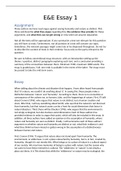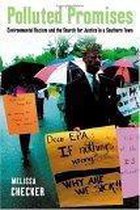E&E Essay 1
Assignment
Many authors we have read argue against seeing humanity and nature as distinct. Pick
three and describe what they argue regarding this, the evidence they provide for these
arguments, and what they say we get wrong or miss when we assume separation.
Not all the texts will be appropriate. If you summarize a text not relevant for this question
you will have to redo. Furthermore, not all portions of a text will concern our topic.
Sometimes, the relevant passages might come late or be dispersed throughout. Do not try
to describe the content of texts in their entirety: focus only on the parts relevant to the
question.
Be sure to follow conventional essay structure, with an introduction setting up the
theme / question, distinct paragraphs exploring each text, and a conclusion providing a
summary of the connections between them. Minimum 1500, maximum 1800 words. The
essay is graded pass / fail; one redo is available in the event of the latter. The essay must
be passed to take the mid-term exam.
Essay
When talking about the climate and disasters that happen, I have often heard from people
that ‘it’s nature, we couldn’t do anything about it’. In saying this, these people make a
distinction between ‘nature’ and ‘humanity’. According to them, there is no connection or
consequence of the actions we, as humans, take, and the happenings of nature. First, I’ll talk
about Cronon (1996), who argues that nature is not distinct, but a human creation and
more. After that, I will say something about Smith, who says that the natural is not divorced
from humanity, but that natural causes can be a front for social dimensions that factor in
natural disasters. Third, there will be Checker (1996), who argues that the environment is
not simply ecological, but also involves social dimensions. Each of these authors has
provided evidence in order to argue their point, which will also be included in this essay. In
addition, all three authors have added an opinion on the assumption of humanity, where
nature and humanity are seen as distinct. Finally, I will summarize each of these authors’
argument on whether nature and humanity are distinct or not, what their evidence is and
what they think has been missed or gotten wrong in the assumption of a distinctiveness
between human and nature.
First, Cronon (1996: 7) argues that nature does not stand apart from humanity. The
environment, or wilderness, is not a place untouched by humanity, but is, in fact, created by
humanity, though it is not merely this. What brings us to a place of nature is a cultural aspect
of our society. We may have memories of being in a place with nature, but the reason why
we came to have these memories is cultural. The ‘wilderness’ or ‘nature’ is not simply a
place out there, it is This shows that while the ‘wilderness’ or nature may be ecological, the
, reason why we have the memories of these places and appreciate them is cultural and so
connected to humanity.
Cronon (1996: 10) finds evidence for his argument in how ‘wilderness’ or the environment
has come to be influential in society. In order to become as influential as it is, according to
Cronon (1996: 10), the environment had to become sacred and loaded with values that a
particular society values. This demonstrates that nature and society, or humanity, are not
distinct from each other. Rather, the viewpoint of the environment or ‘wilderness’ as
important or influential is a product of humanity, which again demonstrates the connection
between them.
Though Cronon (1996) argues that nature does not stand apart from humanity, he also tells
us a few things which humanity has missed or gotten wrong when we assume a separation
of nature and humanity. Cronon (1996: 16) tells us that we get it wrong when we think
wilderness or the environment allows us to escape our problems or past. This, he says, is an
illusion, no matter from which angle you look at it. This is emphasized when he notes that
we, as humans, see the wilderness as the good in our lives and in the world, while we see
our modernity as the negativity in our lives (Cronon, 1996: 17).
Second, Smith (2006) argues that even among climatic events, there are not simply natural
causes, but there are also social causes of climatic events or disasters. Additionally, when it
is said that there are only ‘natural’ causes of climatic events, Smith (2006) argues that it can
mask social, political and economic dimensions. This means that Smith (2006) as well argues
that nature and humanity are not completely distinct.
Smith’s (2006) evidence regarding this concerns the inadequacy of preparations for
hurricane Katrina. He supports this by giving several examples of the consequences of
Katrina and how it affected people’s lives for the worse in New Orleans. Later, he argues that
in places where enough protective measures have been taken, such as Cuba, the damage
was less and no-one died. This shows that a disaster or climatic event is not simply natural,
but is often impacted by other causes, such as political, economic and social causes as well.
Yet, Smith (2006) further argues that there is still something we get wrong when it comes to
the distinction between humanity and nature. Specifically, nature and humanity are not
separate and we as humans do influence the climatic event or the consequences of this. It is
not just a ‘natural’ disaster, humanity plays a role as well.
Third, Checker (2005) argues against a distinction between humanity and nature, as Cronon
(1996) and Smith (2006) do. She claims regarding humans, that they are connected to the
environment and the consequences of environmental issues in the fact that humans affect
the environment, while the environment also impacts human lives. Moreover, the
environment is not just ‘natural, but includes social factors, such as housing and safety
(Checker, 2005: 17), which also influences the consequences of climatic events. So, Checker
(2005) argues, the ecological pollution and social pollution influence each other in a vicious
cycle and nature and humanity are not separate.






